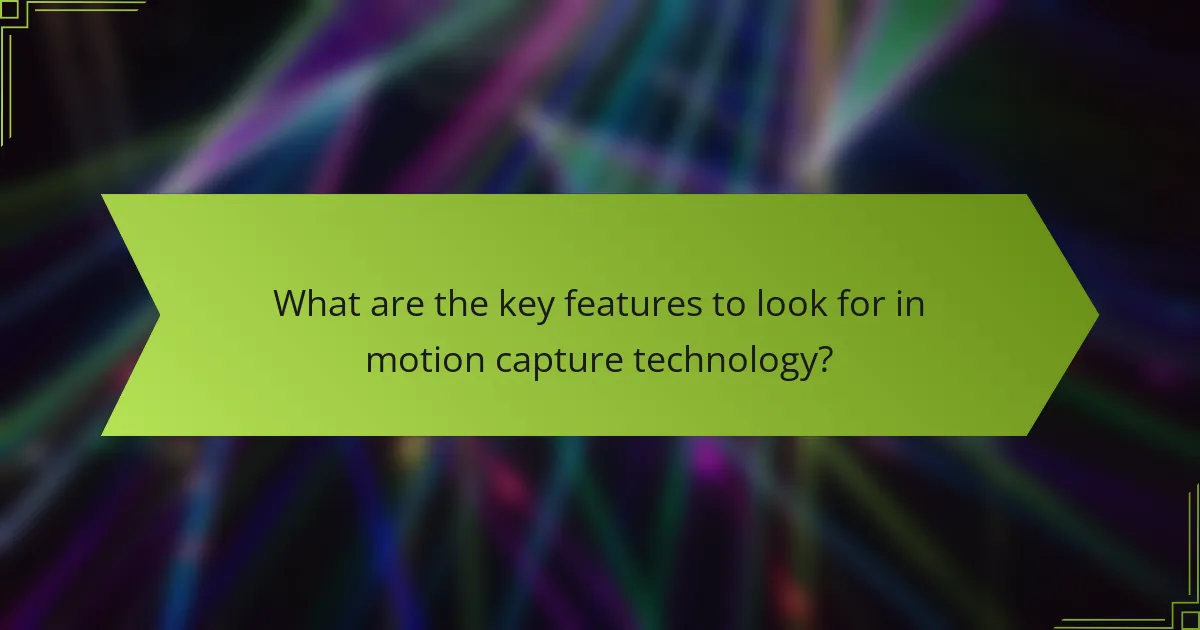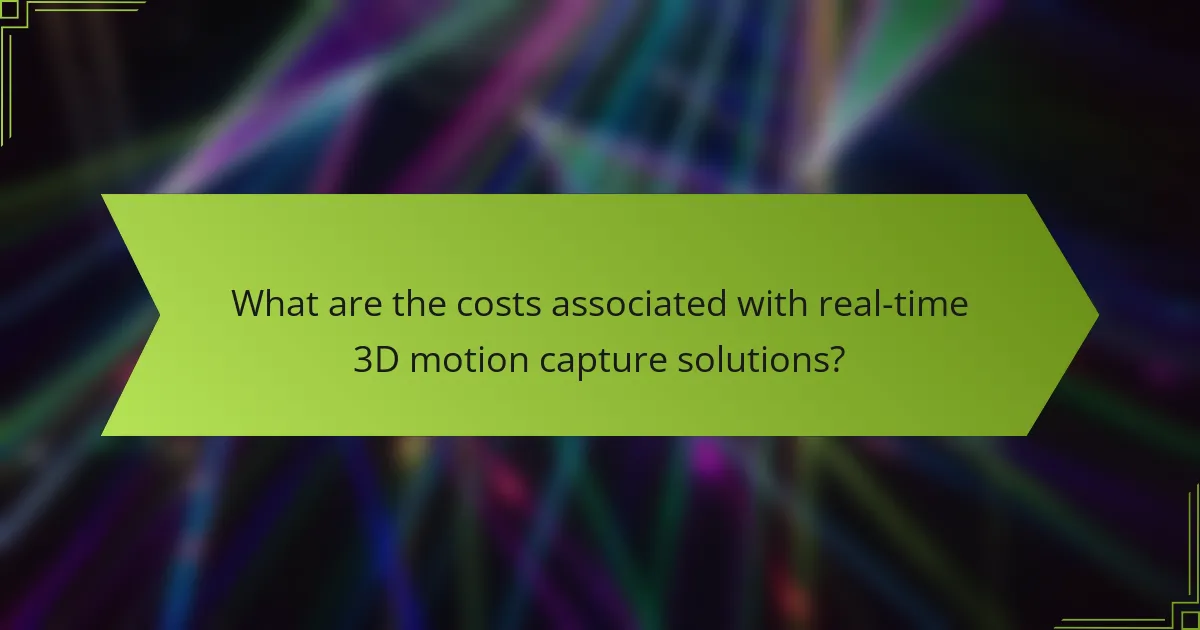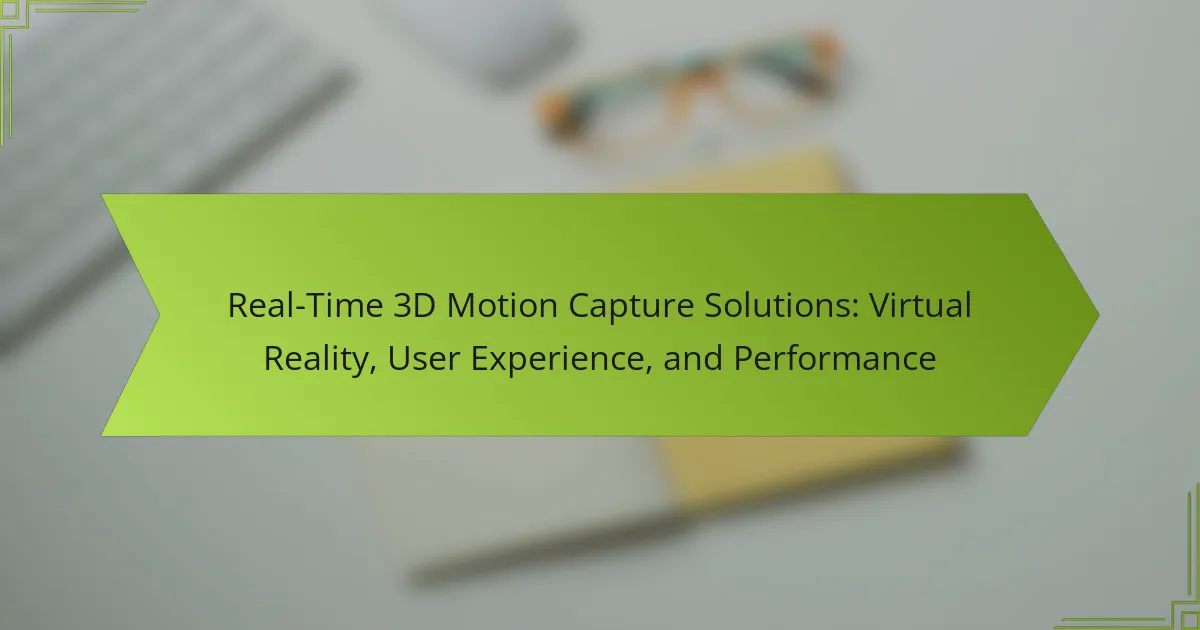Real-time 3D motion capture solutions play a crucial role in enhancing virtual reality experiences by providing high accuracy and low latency. These technologies enable users to interact seamlessly with digital environments, translating their movements into realistic avatars and interactions. As a result, they significantly improve user engagement and immersion in various applications, including gaming and virtual simulations.

What are the best real-time 3D motion capture solutions for virtual reality?
The best real-time 3D motion capture solutions for virtual reality include systems that provide high accuracy, low latency, and ease of integration with VR platforms. These solutions are essential for creating immersive experiences and enhancing user interaction in virtual environments.
Vicon Motion Systems
Vicon Motion Systems is renowned for its high-precision motion capture technology, widely used in film, gaming, and VR applications. Their systems utilize optical markers and cameras to track movements with sub-millimeter accuracy, making them ideal for detailed character animations.
When considering Vicon, evaluate the setup costs and the space required for optimal camera placement. Their solutions often require a dedicated studio environment, which may not be feasible for all users.
OptiTrack
OptiTrack offers robust motion capture solutions that are particularly popular in the gaming and VR industries. Their systems are known for their flexibility and scalability, allowing users to capture motion in various environments, from small studios to large arenas.
OptiTrack’s software is user-friendly, making it easier to integrate with existing VR platforms. However, users should be aware of the potential need for additional hardware, such as cameras and markers, which can increase overall costs.
Qualisys
Qualisys specializes in motion capture technology that combines optical and inertial systems for enhanced performance. Their solutions are suitable for both indoor and outdoor use, providing versatility for various applications, including sports and biomechanics.
Qualisys systems are known for their real-time data processing capabilities, which can significantly reduce post-production time. Users should consider the learning curve associated with their software, as it may require some training to maximize its potential.
Perception Neuron
Perception Neuron offers an affordable and portable motion capture solution that uses inertial sensors for tracking. This makes it accessible for independent developers and smaller studios looking to create VR content without significant investment.
While Perception Neuron is easy to set up and use, it may not provide the same level of accuracy as optical systems. Users should weigh the trade-offs between cost and precision based on their specific project needs.
Motion Analysis Corporation
Motion Analysis Corporation provides advanced motion capture systems that are widely used in professional sports and medical applications. Their technology is designed for high fidelity and can capture complex movements with great detail.
When choosing Motion Analysis, consider the system’s compatibility with VR platforms and the support available for integration. Their solutions typically come with a higher price tag, reflecting the quality and capabilities offered.

How do real-time 3D motion capture solutions enhance user experience?
Real-time 3D motion capture solutions significantly enhance user experience by enabling more interactive, realistic, and immersive environments. These technologies track and translate user movements into digital avatars or environments, allowing for a seamless interaction that feels natural and engaging.
Improved interactivity
Real-time motion capture allows users to interact with virtual environments in a fluid manner. For example, in gaming, players can control their avatars through physical movements, leading to a more engaging experience. This interactivity can be further enhanced with haptic feedback, providing tactile responses that mimic real-world sensations.
To maximize interactivity, developers should focus on minimizing latency, ideally keeping it under 20 milliseconds. This ensures that user actions are reflected in the virtual environment almost instantaneously, which is crucial for maintaining immersion.
Realistic animations
Motion capture technology creates lifelike animations by capturing the nuances of human movement. This results in characters and avatars that move in a way that feels authentic, enhancing the overall experience. For instance, in film and virtual reality, realistic animations can convey emotions and reactions that resonate with users.
Using advanced algorithms and machine learning, developers can refine these animations further, allowing for smoother transitions and more complex movements. It’s essential to balance realism with performance; overly detailed animations may require more processing power, potentially affecting user experience.
Enhanced immersion
Immersion is a key aspect of user experience in virtual environments, and real-time motion capture plays a vital role in achieving it. By accurately reflecting user movements, these solutions create a sense of presence that draws users deeper into the experience. This is particularly important in applications like training simulations and virtual tours.
To enhance immersion, consider integrating audio cues and environmental feedback alongside motion capture. For example, synchronized sound effects that respond to user actions can significantly elevate the sense of realism. Additionally, ensuring compatibility with various VR headsets can broaden accessibility and improve user engagement.

What are the key features to look for in motion capture technology?
When evaluating motion capture technology, key features include accuracy, latency, and integration capabilities. These elements significantly impact the overall user experience and performance in applications such as virtual reality and gaming.
Accuracy and precision
Accuracy refers to how closely the motion capture data reflects the actual movements of the subject. Precision is about the consistency of these measurements over time. High-quality motion capture systems typically achieve accuracy within a few millimeters, which is crucial for applications requiring detailed feedback, such as virtual reality simulations.
To ensure you select a system with the necessary accuracy and precision, consider the type of sensors used, the environment in which they operate, and the calibration methods employed. Systems that utilize optical tracking often provide superior accuracy compared to inertial systems, especially in controlled settings.
Latency and speed
Latency is the delay between the actual movement and the corresponding data output, while speed refers to how quickly the system can process and transmit this data. For immersive experiences, a latency of less than 20 milliseconds is generally considered acceptable, as higher latency can disrupt the user experience and lead to motion sickness.
When assessing latency and speed, look for systems that offer real-time processing capabilities and low-latency communication protocols. This is particularly important in applications like gaming or live performances, where immediate feedback is essential for user engagement.
Integration capabilities
Integration capabilities determine how well the motion capture technology can work with other systems and software. A versatile motion capture solution should easily integrate with game engines, animation software, and VR platforms to streamline workflows and enhance user experience.
Evaluate the compatibility of the motion capture system with existing tools and platforms you plan to use. Systems that support industry-standard protocols, such as Open Sound Control (OSC) or Motion Analysis, can facilitate smoother integration and reduce setup time.

How do I choose the right motion capture system for my project?
Choosing the right motion capture system involves understanding your project’s specific needs, budget, and future growth potential. Assessing these factors will help ensure that the system you select aligns with your goals and provides the best user experience.
Assess project requirements
Start by clearly defining the objectives of your project. Consider the type of motion capture needed—whether it’s for virtual reality, animation, or performance analysis. Each application may require different levels of precision and tracking capabilities.
Next, evaluate the environment where the motion capture will take place. Indoor settings may allow for more controlled conditions, while outdoor setups might need robust systems that can handle varying lighting and space constraints.
Evaluate budget constraints
Your budget will significantly influence your choice of motion capture systems. Basic setups can start in the low thousands of USD, while advanced systems may reach tens of thousands. Determine what features are essential and where you can compromise to stay within budget.
Consider not only the initial purchase price but also ongoing costs such as software licenses, maintenance, and potential upgrades. It’s wise to allocate funds for training personnel to effectively use the system, as this can enhance the overall return on investment.
Consider scalability options
Scalability is crucial for projects that may expand over time. Look for motion capture systems that allow for easy integration of additional cameras or sensors as your needs grow. This flexibility can save you from having to invest in a completely new system later on.
Additionally, assess whether the software can handle increased data loads or more complex animations without significant performance drops. Systems that support modular upgrades or cloud-based solutions often provide better long-term value.

What are the costs associated with real-time 3D motion capture solutions?
The costs of real-time 3D motion capture solutions can vary widely based on technology, scale, and application. Generally, expenses range from a few thousand to several hundred thousand dollars, depending on the complexity of the setup and the quality of the equipment used.
Hardware Costs
Hardware costs for motion capture systems typically include cameras, sensors, and computing equipment. Entry-level systems may start around $5,000, while professional-grade setups can exceed $100,000. Considerations include the number of cameras needed for accurate capture and the type of sensors, such as optical or inertial.
Software Costs
Software for processing and analyzing motion capture data is another significant expense. Licensing fees for professional software can range from a few hundred to several thousand dollars annually. Some systems offer bundled software, which may provide cost savings but could limit flexibility.
Maintenance and Support Costs
Ongoing maintenance and support costs should also be factored into the budget. This can include software updates, hardware repairs, and technical support, which may amount to 10-20% of the initial investment per year. Regular maintenance ensures optimal performance and longevity of the equipment.
Training and Operational Costs
Training personnel to operate motion capture systems effectively is essential and can incur additional costs. Workshops or courses may cost anywhere from a few hundred to several thousand dollars per participant. Additionally, operational costs such as studio space and power consumption should be considered when budgeting for a motion capture project.
